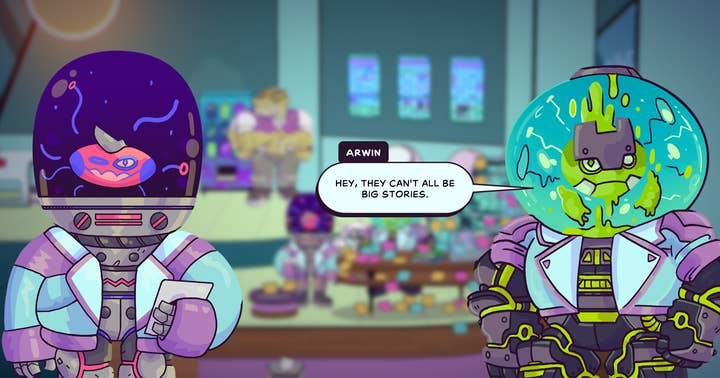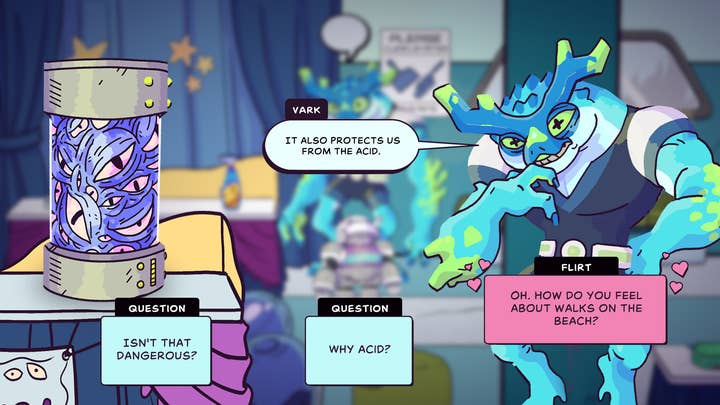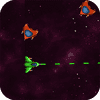Copychaser Games’ plan for story-focused titles
Sign up for the GI Daily and get the day’s top stories sent to your inbox.
It’s not easy to write a great story since readers can miss the jokes or have trouble connecting with the characters. Having an engaging story keeps readers coming back for more, so that benefit remains constant.
The GamesIndustry.biz ConsultationBen Gelinas, a former Bioware employee and the current inventive director, creator, and manufacturer for Copychaser Games, discusses the finer points of plot development. He also explains the company’s plans for its new name, Times & & Galaxy.
After Gelinas left BioWare in 2017, the company was soon established. Over the course of his five years there, he scored games including Mass Effect 3 and Dragon Age: Inquisition, as well as the upcoming Mass Effect: Andromeda. Speed Dating for Ghosts, Copychaser’s inaugural release, debuted on Steam in 2018, and then across several platforms in 2020. Gelinas, Mikey Hamm, Andrew Carvalho, and Doug Hoyer made comprised the little team that won the championship.
Copychaser Games, according to Gelinas, approaches fresh stories by investigating characters and situations in unusual contexts. Spirits are often linked to morbid ideas like haunting and death. From there, the idea shifted to placing them in a new environment, dating, and thus Speed Dating for Ghosts was born.
More people and money usually means more potential problems and obstacles.
Leaving AAA video game creation facilitated the fresh perspective on story development. He tells GamesIndustry.biz, “… we tend to see the exact same basic stories, archetypes, and viewpoints duplicated– especially in the AAA area.” This suggests that there is room for expansion in the storytelling potential of video games.
According to Gelinas, the larger the organisation, the more compartmentalised the writer’s work becomes. “More manpower and resources usually indicate more complexities and unknowns. Because of this, the story’s edges are occasionally rounded off. As an indie author, my duties extend much beyond just writing. And there are a lot more limits on the kinds of gameplay, audio, and visuals we can implement,” Gelinas says.

Gelinas also highlights the difference in scale that comes with the advent of independent development. He was the company’s sole full-time employee; the rest of the staff handled their responsibilities alongside other commitments. The company not only outsources game development, but also other services like writing and art design.
Copychaser has tackled games like Remedy Entertainment’s Control and Warner Bros. Games’ Gotham Knights.
For vital technical and artistic support, we also work with other independent firms like Laundry Bear and Sleeping Giant. Everyone on Times & & Galaxy works from home or shared office spaces in Edmonton, the Greater Toronto Area, or, in the case of our character artist, New Jersey; we do not have a dedicated studio space. We’re a small but tenacious team,” he says.
“Those limitations lead to something more traditional and, in the case of Copychaser, peculiar. I want to be able to play in a smaller box, knowing its limits but giving myself enough room to use them to their fullest.
The brand-new Times & & Galaxy is giving Gelinas and the studio a chance to put their newfound knowledge of journalism to use. The title was inspired by the audience, Gelinas’s experience in journalism, and his love of science fiction. More authors, including Sunny Evans, Paul Blinov, and Tess Degenstein, contribute to the inventive group of this larger title.
Developing “distinct, inclusive computer game with branching stories and remarkable characters,” as Gelinas puts it, is Copychaser’s overarching strategy for advancing narrative development. The player is the centre of attention in every Copychaser game, which features a unique and engaging tale.
We started in a similar place with Times & & Galaxy, with local newspaper reporting in an outlandish science fiction universe. All of us, from the artists to the musicians to the programmers, must first and foremost buy into the mood of this game.
I try to get everyone in the team to agree that “no” is always too far.
‘…I encourage everyone on the group to never say, ‘No, that’s too far,'” he goes on. Their job is to exert force, and mine is to let them know when they’ve gone too far. When I become too excited about a stupid idea, the roles tend to switch.
“Players asked if they could play a game with a cast of reactive and deep characters, in a setting with super-detailed tradition, but without a story that needed them to eliminate things every 10 minutes,” the developers wrote.
Previous work experience as a local crime reporter inspired the title’s emphasis on journalism. He claims to have met all sorts of interesting people while out on the beat and to have told a wide variety of tales. As a designer, it was exciting to consider the prospect of melding such insights with the playfulness of a video game.
“I also didn’t want to go too dark and too real with the styles,” Gelinas explains. I assumed fewer players would have access to that. Instead, I wanted to design a game set in the future. It was reporting, not the setting itself, that drew players to the outlandish location.

Copychaser decided to use a robot since the concept of yet another sci-fi game with a human or alien protagonist was boring. He preferred it if people were as strange as other species of humanoid.
The use of robots is very common in science fiction. They provide players a new perspective that is nonetheless familiar in some ways.
The use of robots is very common in science fiction. They provide players a new vantage point that is also familiar in certain ways. Also, it’s high time that heroic robots took centre stage. Many well-known robots have appeared in fiction, but “very few of them get to be anything but partners or grunts,” he says.
In our gaming world, robots are still limited to menial tasks that require human intervention. This means they have never been able to take centre stage in their own narratives. At least until your robot is finished being built.
Users might also choose to play as an intern, in the form of a video game, to familiarise themselves with the field of journalism. The protagonist’s transformation into a journalist is crucial to the plot and to the character’s development as a whole.
Gelinas adds that the Copychaser team wants to create more science fiction episodic stories based on real events. The game features “stories about a toy that blows up when you have fun with it excessively; an interplanetary design United Nations that degenerates into a Lord of the Flies circumstance; a robotic battle occasion where the robotics are sentient; and an alien graduation,” he says.
“We jumped into this video game with the attitude of ‘Why the hell not?’ and the result was buckets of stories I’ve never seen before in a video game.”
Players may still find common ground with the diverse influences of the game’s creators despite the games’ distinct narratives.
Gelinas suggests that Star Trek aficionados could enjoy the video game Times & & Galaxy. However, given the genre-loving absurdity of its target audience, the game could appeal to fans of Douglas Adams and Terry Pratchett.
However, it’s important to strike a balance between providing enough background information and losing the reader. Gelinas argues that creating an experience within a setting is easier if more time is spent developing the setting and its characters.
Copychaser and TravelMate are currently working together to publicise the release of Times & & Galaxy.
“They seem like a partner and co-conspirator in our odd vision,” Gelinas says of their assistance. They don’t try to limit our field of view in any way. Instead, they make an effort to learn about our goals and then direct us towards the best possible target market for our offbeat idea.
Making “focused, low-budget story experiences that do not yet exist” has always been the goal.
Times & & Galaxy is the most fervent video game that Gelinas and the Copychaser crew have ever created. The studio is still working towards the same goal. Copychaser’s goal has always been to create “focused, lower budget story experiences that do not yet exist,” he says, and the studio plans to keep developing games that fit that description.
If the new title is commercially successful, he says, all of Copychaser’s employees will be able to go on to the company’s next assignment as full-time employees.
A quote from Gelinas: “For Times & & Galaxy, we were fortunate enough to get Canada Media Fund assistance in addition to assistance from our publisher Fellow Traveller, so we wish to offer enough to make their contributions rewarding.”
We planned on making this game on a low budget (think: horror movie on the cheap), so recouping our investment won’t be too much of a challenge, and anything beyond that is just icing on the cake.
When asked what route designers may take when pitching narrative video games to players, he mentioned that this was an excellent option.
“A game’s story is a major reason why people start and remain playing it. Games have always included narratives. Overcoming an obstacle is the stuff of legends.
Developers have been able to push video game narratives in new directions thanks to the convergence of technology and the expanding capacity to reach niche audiences online. As a consumer market, we have only just begun to explore the potential of the interactive tale. Speculating on the potential future of video game narratives is exciting.
Sign up for the GI Daily and get the day’s top stories sent to your inbox.

























